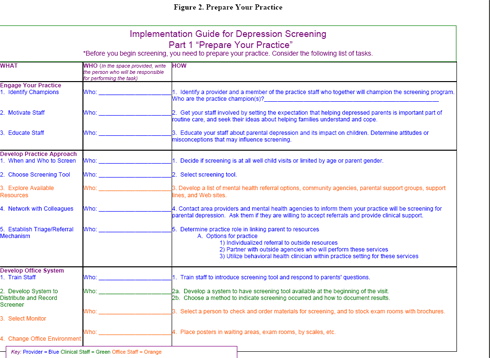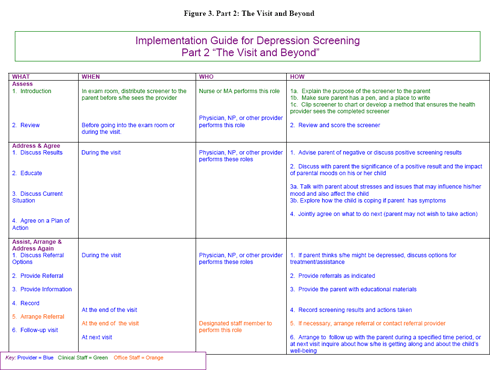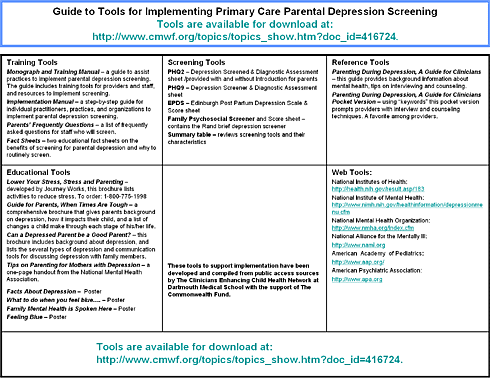Brief parental screening for depressive symptoms is designed to be incorporated into the routine well care of pediatric patients. As with any substantial change in a practice, it is easier to implement if the entire practice is involved. It is important to define the tasks involved in the screening and assign responsibilities to various staff members. The following steps are designed to assist the lead clinician and other staff in setting up a screening program in their practice.
A senior pediatric provider who wishes to add parental depression screening to their practice must champion the program with their colleagues and staff. We recommend forming a small group of about three people (one clinician and one to two staff) to lead the practice through the process of designing and implementing the new screening procedures. Every person in the practice plays a critical role in implementing the screening program, so representatives from all aspects of the operation should be included in the small leadership group.
Figure 2 is a worksheet that summarizes the steps needed to prepare to implement depression screening for parents. These steps are described in more detail below.
Figure 2. Prepare Your Practice (Click on figure to open at full size)

| Practitioner comment: |
| "My partners all went along with screening but we needed one person to rally the team and the staff. Our nursing staff really got behind the screening effort—as mothers, they knew how tough the job could be."
Dr. James Hurley
Monadnock Pediatrics |
PART 1: PREPARE YOUR PRACTICE
Engage Your Practice
Practice staff or other clinicians may have concerns about adding depression screening to routine well care. The first step is to meet with everyone in your practice and engage them in a discussion about the reasons for screening parents for depression and how it will improve patient care. Every person in the practice contributes to patient care, so it is important for every person to understand their role in the process. The clinician champion can present the benefits of screening based on materials in this manual. (A fact sheet for distribution is available in the appendices.)
Staff or clinician burden is a primary consideration in deciding when to implement a change in a practice. Issues such as staff or clinician turnover or being in the middle of a change to an electronic medical record system can affect a practice's ability to initiate and maintain change. Practices should start parental depression screening when other aspects, such as clinical volume, staffing, and medical records systems, are relatively stable.
Develop Your Practice Approach
-
When and Who to Screen
Effective screening requires a systematic method of identifying parents to screen and conducting the screening. Who will be screened? We recommend routinely screening parents who present with their children for well visits. Since depression and depressive symptoms can occur at any time and their severity may fluctuate, screening should be ongoing. If a parent has numerous children in the practice and is seen several times over a few months, you may choose not to screen each time.
Although the screening questionnaire is very brief, discussion with parents who are symptomatic or have concerns may require additional time that is best incorporated into well visits. The well-child visit is also the setting where parents expect to discuss parenting, their child's behavior, and development. All of these areas may be adversely affected by parental depression. In addition, since continuity may foster trust, parents may be more comfortable discussing these issues with their child's regular provider rather than the clinician seeing their child when he/she is sick.
-
Choose a Screening Tool
We recommend a two-question paper survey, the Patient Health Questionnaire 2 (PHQ-2), with a written introduction. These questions have been widely tested and shown to accurately identify adults at high risk for a depressive disorder. Using the two questions in an interview format requires that the pediatric provider remember the two questions, weave them into the interview, and ask them consistently. A copy of our recommended screening form and information on scoring the PHQ-2 is provided in the appendices. The form includes a brief introduction about why their pediatric provider is screening.
The PHQ-2 is a screening tool and does not diagnose depression. Parents who report symptoms or score at risk need to complete a more comprehensive assessment or be referred for assessment and treatment with another clinician. Pediatricians who want to assess the parent further to guide their referral may use the Patient Health Questionnaire 9 (PHQ-9). It asks about each of the DSM-IV diagnostic criteria, and the score provides provisional diagnoses and treatment recommendations. A copy of the PHQ-9 and directions on how to score it are found in the appendices.
A popular depression screening tool for postpartum women is the Edinburgh Postnatal Depression Scale (EPDS). This 10-question scale is designed to identify mothers at risk for perinatal depression. It detects anxiety and depressive symptoms and, if used, the provider should expect more women to screen positive. Some pediatric providers may choose to use this tool during the child's first year. Information on scoring and the questions for the EPDS tool are found in the appendices.
-
Explore Available Resources
One way to identify resources for your patients is to contact mental health and primary care clinicians in your community. After describing the proposed change in your practice, discuss your referral needs and how the referral process would work when you have a parent with an urgent need and one with a routine need. Contacting your local public mental health center about their programs is important as well. A discussion at grand rounds at your local hospital or other medical staff meetings might identify other providers in your community who are interested in addressing this critical issue.
Resources for parents with depression vary widely by community. If the parent is uninsured and does not have a primary care provider there may be services available on a sliding scale or through state-funded programs. You should assign a staff person to review resources and develop a list that includes the type of resources below:
- community mental health centers that offer counseling for parents, children, and families;
- child and family service agencies that offer counseling and support groups;
- community hospital education programs that offer parenting groups;
- child abuse prevention hotlines;
- youth council agencies;
- pastoral counseling agencies that may have a sliding fee schedule;
- information and referral lines in your community to answer questions about mental health resources;
- the telephone book (look under social and human services);
- newspapers, which may list local support groups
Additional information is available on the following Web sites:
- National Institute of Mental Health: www.nimh.nih.gov
- American Psychological Association: www.apa.org
- National Alliance on Mental Illness: www.nami.org
- Establish Triage/Referral Mechanism
Before you establish the details of how your office will systematically screen, you need to establish mechanisms to respond efficiently to positive screens within the practice. The majority of those patients will have a primary care provider and may be referred to them for additional assessment and treatment. If you do not identify an organization that can provide additional assessment, a staff member may be trained to score the PHQ-9 and refer the patient as needed. If your practice has a social worker or case manager, this person could assume the task of further assessment of depression and referral as appropriate.
Develop an Office System
After developing a protocol for who to screen, when to screen, what screening questionnaire to use, and how to support parents who screen positive, the next step is to define a systematic office-wide approach or "office system." This process consists of defining each step or task, the roles of clinicians and staff, and "tools" (e.g., screening questionnaire, handouts, and posters) and considering how to integrate these new tasks into existing patient care. The role of the pediatric provider in parental depression screening has been described earlier. However, many of these tasks can be delegated to staff. This process is outlined on the worksheet "Part 2: The Visit and Beyond" and described in more detail in the following section of the manual.
-
Train Staff
Introduction of the screening is important to your patients' acceptance of this process. Below is a sample script that has been used to inform parents about depression screening during their child's visit. If the screen is asked on a separate paper survey, an introduction can be included on the survey.
"Since you were last here, we have implemented a new program that includes a depression screening tool. We know that a parent's mood and emotional health significantly affect children, so we are interested in identifying and referring parents who might be depressed. I will leave this short questionnaire with you and I would like you to discuss it with Dr. Jones when s/he comes in to see Johnny. There are also some educational brochures on the table for you to read. Please feel free to take any that interest you."
"As part of our routine care of your child, we are asking all parents who come in with their children to complete a depression screening form. We know that depression affects both parents and their children, so we are asking for this information as a part of your child's routine care. After you complete the form, Dr. Jones will discuss the results with you and offer some resources that can be helpful if you are interested."
It is important that practice staff who distribute or collect the survey information are comfortable dealing with common patient questions. A list of frequently asked questions and possible responses is included in the appendices. If your practice decides to offer parents further assessment or referral assistance, appropriate staff will need to receive training on the PHQ-9 and referrals procedures.
-
Develop System to Distribute Screener and Record Results
Once your practice decides which parents will be screened, it is necessary to develop a system to identify those parents when they present at the practice. Your practice probably has a system for identifying types of visits and paperwork for each type of visit. Your decision about when you will screen the parent and which tools you will use may be determined, in part, by your current processes, such as using a paper health history or an electronic medical record (EMR). As with other assessments, the results need to be documented in a consistent manner. If a paper screener is used this may be charted or results of the screener may be noted in a problem list, visit notes, or other location based on other documentation of the events of a visit.
-
Change Office Environment and Select Monitor
In addition to discussing parental depression during visits, a practice can heighten parental awareness and education about depression by placing posters and brochures in waiting rooms, hallways near scales, bathrooms, and exam rooms. Posters and other educational materials are provided in the appendices. As with all patient education materials, a staff member needs to monitor their availability and keep adequate supplies in designated areas.
PART 2: THE VISIT AND BEYOND
It is important to involve the entire office in developing the office systems. A simple method for determining how to incorporate parental depression screening into your practice is a "walk through." Pretend that you are a parent coming to a well visit and examine the activities that occur at each encounter during the visit. Ask yourself the following: Who does the parent speak with first? What is the parent asked during this first encounter? Do you want to add a screening task to this encounter? How would you do that? Repeat this process for each person the parent encounters: the individual who prepares the child for the visit, the clinician, the check-out person, etc.
Figure 3. Part 2: The Visit and Beyond (Click on figure to open at full size)

The steps described in the worksheet "Part 2, The Visit and Beyond" are based on our experiences in primary care practices that implemented parental screening. The worksheet is color-coded to suggest which person in the practice might complete each task. One way to ensure consistent screening is to incorporate screening tasks into a job description, just as measuring height, weight, and blood pressure are incorporated into the job of a roomer, who prepares the child for the visit.
This manual includes a set of tools to help your practice carry out the tasks required to screen for parental depression. All staff involved in the planned approach should be trained in the use of the tools and the approach. Most practices will be able to integrate the defined tasks into existing procedures rather than developing new steps or tools. For example, the PHQ-2 can be added to a paper health history, the results noted in the problem list, etc. If an EMR is used the system can be set up to prompt discussion of the PHQ-2, recording the results in the problem list, or tracking referrals.
Practices found that some of the posters that were strategically placed in the rooms, lobby, or by the baby scales prepared families for the screening and discussion. Access to educational materials and Web resources in the rooms made the clinician's discussion of both parental depression and parenting issues more efficient.
Figure 4. Tools for Training and Implementation (Click figure to open at full size)



